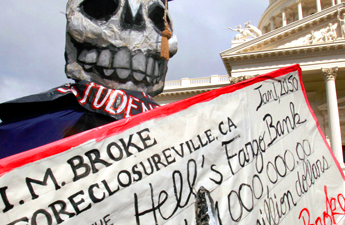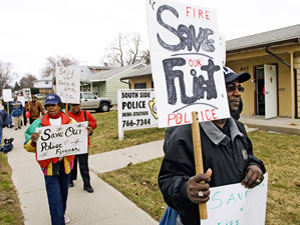CHARLENEM
Budget cuts bring pain and relief isn’t in sight

(FinalCall.com) – When Zakiyah Ansari hears about budgets and cuts, she knows one thing is certain: Black and Latino children in the Big Apple are going to lose big.
The parent leader with the New York City Coalition for Educational Justice says plans to cut $1.4 billion from public education are just wrong. Gone will be afterschool programs that keep young people off the streets, out of trouble and more likely to stick with school, she adds.
“It’s a crime because on top of these cuts, the Contracts for Excellence money that was supposed to come to our schools, and targeted to the lowest performing and special needs children, children in high poverty areas, English Language Learners, etc., we didn’t even get that money,” Ms. Ansari complains.
Across America, state, city and local governments are slashing funding for education, healthcare, and other services to try to meet budget shortfalls–but while lawmakers struggle to crunch numbers, they are making decisions that crush lives, say advocates.
More need, less money to help
At least 45 states made cuts that have hit the most vulnerable communities the hardest and the reductions are expected to increase next year, warns the Center on Budget and Policy Priorities, a Washington, D.C.-based fiscal policy think tank.
“It means that there’s a cruel irony taking place. Because of this national recession, the needs of the people are rising dramatically but resources available to states to meet those needs are shrinking. The problem is how do you fill that gap and it’s made more difficult by the fact that this has been the longest, deepest national recession since the Great Depression,” says Jon Sure, of the Center on Budget and Policy Priorities.
Major cities like Los Angeles have threatened to lay off several hundred people and furlough thousands to close a $485 million deficit.
A Republican senator in Huntington Beach, Calif., proposed having inmates pay $25 a day for room and board while locked up, while other jurisdictions have cut back on inmate meals to save money.
In Illinois, a proposal was floated to have school children in class four days a week and other places have discussed charging residents when fire trucks show up to put out blazes and for police cars when officers show up at accidents. These basic services have traditionally relied on tax payments, but with high unemployment and an angry electorate, many politicians are leery of asking for more money.
‘Raise my taxes! Raise my taxes!’
The problem is so bad that some residents are demanding something different: “Raise my taxes! Raise my taxes! Raise my taxes!” shouted some of the 15,000 to 16,000 people who joined a Save Our State protest April 21 in front of the capitol building in Springfield, Ill.
The rally drew state employees, teachers and advocates from social service organizations. They were worried about job losses in the state and program cuts. Fired-up speakers urged the crowd to turn to the Statehouse. They shouted slogans such as “Show some guts!”
Gov. Pat Quinn wants a 33 percent increase in the income tax, but House Democrats have been reluctant to back a hike.

In California on that same day, thousands of peaceful demonstrators ended their 365 mile, 48-day March from Bakersfield on the Capitol steps in Sacramento. Next year, according to the California Budget Project, Governor Arnold Schwarzenegger’s proposed budget cuts would put an end to cash assistance to 1.4 million low income children and parents.
Mississippi Governor Haley Barbour would cut K-12 funding by more than nine percent and close four state mental health clinics, according to Center on Budget and Policy Priorities.
The cuts mean more people flooding already crowded emergency rooms and country hospitals, longer lines at food pantries and more people seeking beds at homeless shelters.
According to the center: Twenty-nine states have made cuts to health care, and 24 states, and the District of Columbia, have slashed programs for the elderly and disabled. Twenty-nine states and the District of Columbia have made cuts to K-12 education and 39 states have cut costs for college level education.
“People understand it because they’re feeling it and in any number of ways,” says Mr. Shure.
“It could be shorter hours at the library, longer lines at motor vehicles. It could be that state parks are closed in some places. While it’s true that in some cases the largest impact is on low income people who depend more on services and to some extent the impact is felt by more vulnerable people in our population–but this is so deep and widespread that it’s being felt by just about everyone,” he adds.
Part of the problem is that usually when a recession ends, it takes a couple of years for state revenues to catch up and states are usually the last to level off unemployment rates. The current downturn is worse than usual, it will now take longer and next year will be worse than the last, he says.
According to the Centre for Research on Globalization, crippled school districts have sent pink slips to 22,000 teachers in California, 17,000 teachers in Illinois, and 15,000 teachers in New York.
Some 19,000 school employees combined in Michigan, New Jersey, and Oklahoma are facing job losses as well.
Zakiyah Ansari, of the New York City Coalition for Educational Justice Now, sees low performing schools threatened with closure, but says a better solution would be to give schools, students, parents, and neighborhoods the power to change schools themselves.
Her coalition is calling for a moratorium on school closings and the establishment of a School Transformation Zone to improve troubled public schools.
“There was a perfect storm involving the mortgage, real estate, finance, loan, and investments of people’s 401K’s into these things- … There was already a problem with jobs because too many were not based on solid manufacturing, but based on paper, temporary stuff, outsourcing, which caused a bunch of people to lose their ability to survive,” says Dr. David Horne, executive director of the California African American Political and Economic Institute.
The question becomes how do federal, state, and county governments continue to serve as many people as possible and deliver as much service as possible, he continues. States are making major changes in hiring and how to get funds, trying to preserve basic police and fire service, but exposing schools, homeless shelters and social services to cuts, he adds.
“Black folks need to understand that the government cannot be the only source to take care of them. We need to either start dealing with a resurrection of our entrepreneurial skills and going more and more into internet services, and small co-ops,” Dr. Horne suggests.
Mr. Shure, of the Center on Budget and Policy Priorities, says the American Recovery and Reinvestment Act, or federal Stimulus Plan, provided some assistance to states. He says Congress should renew some of the stimulus programs to provide more help to states–and states must find different ways to solve money problems
(Associated Press contributed to this report.)












